This week on the Naked Scientists we're exploring our human story, from the use of tools and fire, to ritualistic behaviour. Where did we come from and what makes us special? Chris Smith is joined by some of the world's best fossil experts including one man who's discovered two of our caveman ancestors, and a scientist who can get the original tissues out of remains that are millions of years old.
In this episode

A few million years
with Professor Lee Berger, University of the Witwatersrand, Dr Tomos Proffitt, University of Oxford, Professor Matthew Collins, University of York & University of Copenhagen
To kick us off on our journey through human history it would be good to know  what we actually mean by human - our species the Homo sapiens, the Homo genus - a group that dates back around 2.5 million years or something else altogether? To help us navigate through the messy and political world of palaeoanthropology Chris Smith roped in our guests Lee Berger, Tomos Proffitt and Matthew Collins...
what we actually mean by human - our species the Homo sapiens, the Homo genus - a group that dates back around 2.5 million years or something else altogether? To help us navigate through the messy and political world of palaeoanthropology Chris Smith roped in our guests Lee Berger, Tomos Proffitt and Matthew Collins...
Lee - The genetic record, as well as the fossil record, correspond with an idea that around 6 to 7 million years ago, we split off from an ape somewhere in Africa and began a journey as bipedal apes (we call those the hominins or hominids). And that journey progressed in the old story, at least the simplified story, from first becoming bipedal, then we came down from the trees, we acquired at some point in there, tools. The brains got larger and we set ourselves up there for the origins of the genus Homo, which has typically been viewed as a big-brained species, using relatively complex tools, and that would lead in the last 2 million years or so to the origins of us.
Chris - So between 6 million and 2 million years ago what sorts of creatures - our human relatives - were there knocking around?
Lee - So in the earliest part of this we have creatures that go by the names such as ardipithecus, and then later the australopithecines or australopithecus. Those names aren't really so important. If you think of that earlier period, where you're thinking of something that is effectively more ape-like, traditionally thought of to have a smaller brain, and generally more ape-like bodies, but still bipedal, thick enamel, small canines - things that characterised hominids.
And then after that we had traditionally thought that there was larger brains, more complex tools, more complex behavior, long distance walking - these sorts of things. We've typically put those in the genus Homo.
Chris - What do you think made these sorts of individuals change over time and become ultimately us - what drove them to do that?
Lee - Well you could almost any paleoanthropologists and they'd probably give you a different answer to that. But, traditionally, we viewed it as ecological stresses, responses to the environment that would drive small changes, all these accumulating to build micro changes in a lineage. But I don't want to give the impression of this being sort of straight linear line.
The idea you see of that t-shirt that you see of the evolving human from an ape to a human - that's wrong. And certainly the discoveries of last decades or so in paleoanthropology are showing that we can't view human evolution as simple.
Chris - Now Lee's got us up to roughly 2-ish million years ago, Tomas, so what happens between 2 million years ago and the sort of time when we're around?
Tomas - Well, it's at that point when you start to see stone tools being produced and it's a little bit before that. Very recently, last year, they found the earliest stone tools in Kenya and these are dated to 3.3, so they would have been around the same time as the australopithecines. Traditionally, up until last year, we see the very first stone technology and that has been seen as being associated with Homo habilis, so the first species of the Homo genus.
Chris - So from about 2 million years ago you get this genus Homo comes along and habilis, meaning handy, using hands to make stuff?
Tomos - Yes, absolutely. That stone tool technology stays with Homo habilis, essentially, for around a million years, a bit over a million years. Until you see the onset of the ashmolean, which is a more complex technology but that coincides with the emergence of Homo erectus or ergaster in Africa.
Chris - And that's what? A million years ago?
Tomos - No about 1.7, 1.8 million years ago.
Chris - And then Homo erectus carries on?
Tomos - Absolutely.
Chris - And does that then hand on, Matthew, to Neanderthal - where do they fit into the picture?
Matthew - It was quite simple in the past because we had the Neanderthal and then the modern's come in, and the moderns come in and they wipe the Neanderthals out.
But the things I'm interested in are the molecules. Now the molecules are starting to tell a new and different story because what we're now seeing, of course, first of all is that inside us, we have bits of Neanderthal. But, in addition, there's another group that's been discovered from molecular data, called the Denisovan. And there's even been some hints in the last couple of weeks of another species based entirely on the DNA found in hominid, so-called species X. So, in fact, the story, which was quite simple, seems to be getting evermore complicated.
Chris - Lee - yes do summarise and try and draw these strands together for us...
Lee - I think an important point that comes out of what's been led in here is that we thought we had a very simple record. We thought we had in figured out and archeology seemed to correspond with the fossil record. What I think has been overlooked by paleoanthropologists, archaeologists and, perhaps, the public as well, is the idea that we had almost no direct association of these tools and this archaeology and these cultures with the physical species. We've just assumed that there's just one species at one time, that the fossils that we find in a particular area, broadly in the same time, belong to a particular archeology and yet, that may not be true. As recently as fifteen years ago, I could sit in a conference where you would hear senior scientists say there was only one species living at any one time in the past within our lineage. That was wrong.
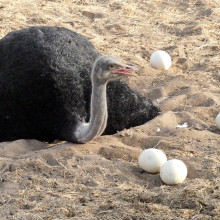
07:26 - 3.8 million year old protein
3.8 million year old protein
with Professor Matthew Collins, The University of York & The University of Copenhagen
When analysing human remains, what if we could look at the genetics themselves? Well that may actually be possible because Matthew Collins and his team have discovered that vestiges of the original tissues can still remain inside a fossil for millions of years, stabilised by their surroundings as he explained to Chris Smith...
Matthew - For me that's the really exciting new findings that have come out in a very short period of time in fact. It's only really in the last decade that we've been able to systematically start to recover molecular data from these fossils.
Chris - By molecular data, just explain what you mean by that?
Matthew - Well, I guess we're all familiar with the idea of DNA. We are all made of our DNA and the discovery was made more like 20 years ago now that some DNA was surviving in some fossils. They were relatively young, so that was from the latest Neanderthals and short, short fragments were surviving.
But then really dramatic changes in technology have developed so much that we can begin to recover far more detailed genetic information. So we've now got complete genomes of Neanderthals and of Denisovans, and what's really remarkable about the Denisovan genome is it comes from nearly a fingernail bone and a tooth. So tiny amounts of material are releasing this wonderful rich molecular data.
The problem with that is that DNA record isn't going that far back in time. So we've already talked about the long 6 million years of evolution. Sadly the DNA record seems to fall away within about four hundred thousand years. So you've got the neanderthals, you've got moderns, but you don't go any further back.
Chris - Why?
Matthew - Well the problem with DNA is that it's a very fragile molecule. Not that fragile because it survives for quite a long time, but it's quite a complex molecule and some of the bonds that create DNA are relatively high energy bonds that are quite easy to break. So what we've been trying to do is look at other molecular sequences. DNA makes a thing called proteins. When you look around, your hair, you skin, that is all protein. So what we have been trying to do is get information, sequence data, from the proteins.
Chris - So just to summarise this then. DNA is a recipe book in a cell. That recipe tells cells how to make proteins so, if you know what proteins a cell is making you can sort of work out what genes must have made it. And you're saying because DNA is more flimsy than proteins, instead of just looking for just DNA, which we can only go about half a million years or so, if we go looking for the proteins, actually we can go back potentially a lot further?
Matthew - Yes, and half a million years is caution because most of the DNA work that's been done has been done in very cold places, and that's not where humans evolved.
Chris - Tell us then, where have you been working and trying to pursue this?
Matthew - So where we've is gone to the classic hominid sites, but we haven't been looking for hominids themselves. We've gone to the humble ostrich eggshell. And the reason for that is because there's a lot of them about, so for developing new techniques it's relatively easy to get hold of the material. Because these sites are so well studied, we have very good dating control on those sites and the eggshells are fairly large. They have proteins trapped inside them and we've been able to develop protocols to get those proteins out.
Chris - You've been to places where people like Lee dig up the remains of our human relatives and they date them very carefully. So, if you find a piece of ostrich egg there in the same sort of context as Lee's digging up stuff he's dated to within an inch of it's life, you could be reasonably confident that your piece of ostrich egg is that date?
Matthew - That's right. The only places that people care to date that kind of material where hominids are found and we've gone to some of the classic hominid sites.
Chris - And how old are these bits of ostrich egg you're looking at?
Matthew - Well, we've deliberately gone progressively back further and further in time because we did not know at what point the sequences would run out. And that was the big surprise, as I say, they went back, and back, and back, and back and, in fact, we still have sequences in the oldest thing that we've so far analysed...
Chris - Which is how old?
Matthew - 3.8 million years.
Chris - So you've got a bit of ostrich egg from 3.8 million years ago?
Matthew - Yes we have.
Chris - And you can get the proteins out of them?
Matthew - And we can get partial protein sequences out. We don't get the full proteome of the ostrich, we get partial protein sequences.
Chris - So, putting this in perspective, when that ostrich laid that egg three point eight million years ago, material that it deposited in the egg is still there and you can extract it?
Matthew - It's DNA told it to make proteins, it made the proteins, the proteins made the eggshell, and some of that sequence still there. I mean it's really remarkable, really remarkable.
Chris - And you can get it out, and can you read the amino acid building blocks that make up the protein so you can work out the genetic code of the ostrich that laid the egg?
Matthew - Yeah. We can only read part of it because not all the protein survives and that's one of the things we've been trying to understand which parts survive and which don't. But, absolutely, we can read the sequence and then we can compare the sequence with the modern ostrich.
Chris - So Lee - are the materials that you are extracting from sites in South Africa of sufficiently high quality in terms of their preservation that you could have a conversation with Matthew, for example, and potentially apply his techniques because the overlap in time with your material?
Lee - Why, we've already had that conversation just this afternoon.
Chris - Oh, right.
Lee - I mean it sort of remarkable doing this in Cambridge. I was at the Eagle pub last night and that's where this all actually started, You know the idea that we're now combining what we thought to be separate streams that would never reach each other. DNA was like a railroad track running next to a river which was the hominid fossil record and protein was off on the other side. That we're now seeing these incredible advances that are bringing all three of these critical sciences, each needing each other, into building a picture of the complexity of where ostriches come from, but also where our lineage comes from and what it did at any one time.
Chris - The way I was getting at this is that if Matthew can work out at the least the partial genetic code of an ostrich, can we pull the same stunt for Homo naledi, one of the species that you have uncovered? Do you have the material that could be amenable to this?
Lee - I can tell you we will try it. I mean I think all of us are concerned about the destruction of relatively precious material, for these sort of states particularly in the early stages. But the fantastic point is that as we are beginning to push people further and further by saying "no you can't until you get the technique on smaller amounts." But it will happen and we are going to learn extraordinary things I would predict.
Chris - How much stuff do you need Matthew to do this?
Matthew - Well I mean Lee's quite right, we should not be destroying samples until we know exactly what we're doing. We're working with pretty small samples of ostrich eggshell at the moment considerably less than a teaspoon full of salt, but still I think we can get better. And what we want to try and do is get as much information as we can out of these samples. We're still in the stages of developing the techniques before we work on these really valuable fossils.
Chris - And what has changed in recent years that means that you are now able to do this where you couldn't before - how do you do it?
Matthew - We have ridden on the back of medical technology in a sense. People, once they'd sequenced the genome, they became interested in what the DNA was doing, so looking for the proteins, and so the medical world has been developing more rapid, and more sensitive instrumentation. And what's been remarkable for us is it wasn't possible with the instruments from the last generation, it's only the last couple of years the machines have been good enough to detect these tiny amounts of proteins, and also to map the damage on the proteins so we can actually tell and ancient from a modern sample.
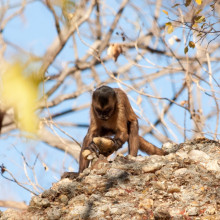
14:40 - Use of tools, a monkey-made phenomenon?
Use of tools, a monkey-made phenomenon?
with Dr Tomos Proffitt, The University of Oxford
Matthew's ostrich eggs came from hominid sites - areas that have been identified 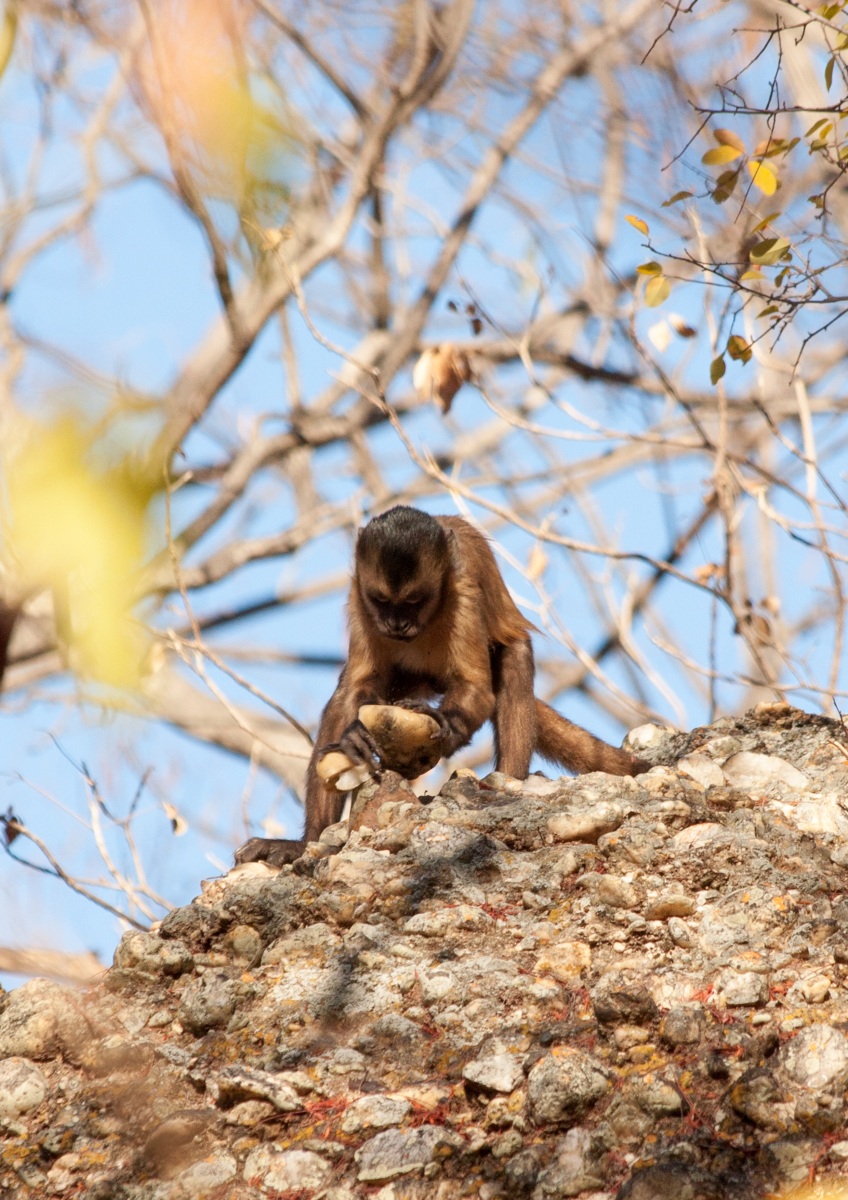 as places of early human activity either through the discovery of human remains or through other artifacts considered to be uniquely human. One such artifact is a particular type of stone tool that has been found in sites as old as 3.3 million years and used as a marker for human activity. But, in a paper in Nature last month Oxford University's Tomos Proffitt speculated that these "tools" may have a different story to tell. He brought some examples in to show Chris Smith...
as places of early human activity either through the discovery of human remains or through other artifacts considered to be uniquely human. One such artifact is a particular type of stone tool that has been found in sites as old as 3.3 million years and used as a marker for human activity. But, in a paper in Nature last month Oxford University's Tomos Proffitt speculated that these "tools" may have a different story to tell. He brought some examples in to show Chris Smith...
Tomos - Okay. So what we have here are stone flakes and they're made from various raw materials that we find in East Africa. So we have some lava, some basalt flakes, and we have some quartzite flake, which is this incredibly pretty looking white, translucent material.
Chris - By flakes you're just saying thin slivers of rock?
Tomos - Thin slivers of stone, basically, that have been taken off a larger core, a larger piece of stone. And the way that hominins produced these flakes, and this is one of the characteristic tools we see in the archeological record and the material record of hominins, is through a process called knapping, and they produce these flakes in a controlled fashion through a very specific mechanism called "conchoidal fracture." We do not see this conchoidal fracture repeated or evident in the natural world and we definitely don't see it often in the primate world. Even though primates use stone tools, they use them for nut cracking and for various percussive behaviours. The way that these types of flakes are produced is not the same process that you see with the nut cracker.
Chris - So, basically, these are of a particular shape or configuration that nature just wouldn't do that?
Tomos - Absolutely. You very rarely get a sharp cutting edged flake produced naturally by nature. What we find even in the very earliest archeological assemblages are many, many flakes in the same place so it's a very hominin behaviour.
Chris - So what have been doing with your monkeys?
Tomos - Iin Northeast Brazil we have a number of groups of Capuchins that live in Serra da Capivara National Park.
Chris - These are just monkeys?
Tomos - These are just monkeys. These are New World monkeys, they're Capuchin monkeys and they're one of the three tool using primates that we know of. And what we have with the Capuchins is they use stone tools for a much more varied range of behaviours than any other primate and they use them for nut cracking the same as other primates. They use them for digging - the ground is relatively hard in this part of Brazil so they will use them to loosen up the ground to dig for spiders and for roots. And they use them for sexual displays, so the females will throw them at the males.
Chris - Gosh! That's some valentines gift isn't it?
Tomos - Absolutely, yes.
Chris - Get hit by a rock. How does that work?
Tomos - Well, it's just a way of getting attention I think. I think that's all it is. But they also do this very strange behaviour which we've called "stone on stone percussion" and it's where a Capuchin will pick up a hammer stone and repeatedly impact another quartz cobalt.
Chris - Just bash them together?
Tomos - Basically the quartz cobalt is imbedded in a conglomerate, it's embedded in a cliff face and the Capuchins will climb up onto the cliff face with their hammer stone and they will repeatedly hit this embedded stone.
Chris - Now are you telling me that they do this interesting behaviour and go and smash stones together because you are going to go in the direction that sometimes the stones break?
Tomos - Absolutely! So the hammer stone that they're using, the hammer stone that they're holding with their hands will, relatively frequently, break, they will fracture. And because it's quartzite, because it's a raw material which is very amenable to this type of conchoidal fracture, entirely unintentionally what these Capuchins are doing, they are producing many flakes. The stone artifacts that they are leaving on the ground, the primate archaeological record, about 30% of that assemblage are flakes. It isn't the same number of flakes that you see by hominins but they do have the exact same characteristics.
Chris - Is one possibility then that actually, when we say we find these flakes at important sites where early human relatives were active that, in fact, we're inferring that this is evidence of early human activity when, in fact, it could have been simple early primates like your Capuchin monkeys knocking stones together and making these flakes?
Tomos - So there's quite an important distinction here I think. The early archaeological record is far more complex than anything we see produced by the Capuchins. The hominins are making flakes in ways that are more complex and a much more varied way. They're also producing a lot more flakes than the Capuchins will ever produce. And we know the hominins are often using these flakes for butchering and cutting organic materials like plants or wood.
So, we know the hominins are producing the flake as a tool. Whereas, with the Capuchins, they're producing a flake unintentionally and they're never using it, they never have any intention of ever using a sharp cutting edge.
Chris - But could we nonetheless be mislead when we find these flakes into thinking that was evidence that humans and our ancestors, our human relatives were active in a site and, in fact, they weren't, it was these monkeys?
Tomos - So yes. If I found these materials in correctly dated sediments in East Africa (2-3 million years ago) without knowing that primates do this behaviour, I would automatically assume that these were artifacts and the only known individual, the only known species that make these types of artifacts are hominins. But I think what's really important and really interesting about this material is it gives us an insight into the processes that may have led to the emergence of stone tools technology, not that we have reclassify.
Chris - Well I was going to say what does this do to our thinking - what are the implications off the back of the paper you've published on this?
Tomos - What we have here is another primate that gives a window into what type of behaviour may have led to the production of flakes, which may have given the correct environmental produced sharp cutting edges and put then in the environment for them to use.
Chris - Is another important interpretation or deduction from this that that the ability to make these things - we've always ascribed that to a highly intelligent or a developing intellect - yet you're showing here that with these beautiful stones that something with actually a very small brain is capable, nonetheless, of producing something that is quite useful.
Tomos - Yeah, absolutely. The fraction mechanic (conchoidal fracture) has long been seen as a watershed moment in hominin evolution. The understanding of this fraction mechanic opened up the world of stone tool technology to hominins. And now we see that, actually, conchoidal fracture isn't necessarily unique to hominins now. It's now unique to primates, modern monkeys are producing this type of material and, exactly, they don't have a particularly large brain. They also have incredibly, compared to hominin hands, relatively unadvanced hands. So they are hands that are hands that have advanced for arboreal tree climbing basically. They haven't evolved for tool use and they haven't evolved for the same range of motions as human hands have. So we have questions about how complex hand morphology has to be to produce archaeological material that we would classify as uniquely human.
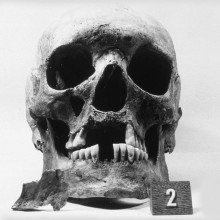
21:40 - Chewing through the fossil record
Chewing through the fossil record
with Dr María Martinón-Torres, University College London
The presence of tools are often used to show a hominin site but the clues are 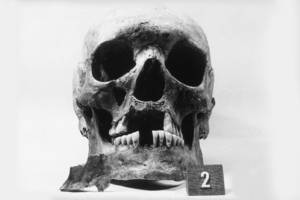 even clearer if you find human or human relative remains. But how much can a piece of skeleton really tell you? Connie Orbach went to meet UCL's María Martinón-Torres who has been getting her teeth into the subject...
even clearer if you find human or human relative remains. But how much can a piece of skeleton really tell you? Connie Orbach went to meet UCL's María Martinón-Torres who has been getting her teeth into the subject...
Maria - We really look at the skeletons and the skeletons will show very important differences between species that we can really try to investigate and to understand what the anatomy was well-suited for. Which type of behaviour, locomotion they were having or changes throughout human evolution, so we were more robust now we're more gracile.
But, particularly, in this aspect, it is very interesting to look at the dentition because teeth are really, really very useful apart from being the skeletal part that usually gets more well-preserved in the fossil record. But the interesting part about teeth is the size but mostly the shape of the teeth are genetically designed. So, in a way, they are really reflecting in a very conservative manner some of type of genetic inheritance. So all those little cusps, grooves we see, those little tubercles and things that we are looking at, each of those traits have a strong genetic component. So, you know, we can't always look at the genes to really see the genetics of the species because the DNA is not always preserved. But by comparing this pattern of grooves, cusps and the shape of the teeth we can really try to infer the type of kinship there was with extinct species.
Connie - And have you got any examples that you can show me
Maria - Yes, sure.
Connie - Oh fantastic... Oh specimen store - Oh my gosh. There's so many skulls.
Maria - Yes. This is a chimpanzee, a female chimpanzee and this is a human. This is a Paranthropus or a robust Australopithecus and this is a gracile Australopithecus like the group that Lucy belonged to.
Connie - Okay. What can we see from the teeth here?
Maria - I would say that the big difference is that homosapiens became very boring, very simple. We have very simplified teeth, very small in general, in absolute and relative terms we have small teeth, but it's not only about size. If you look at the morphology you have quite simple occlusal faces, the part you use for chewing. You don't really see many features, many grooves - yes, quite simple.
However, the teeth of other species that were more primitive. Here I'm showing you for example a Australopithecus robustus. It's not only about the size which you can really see the difference...
Connie - Yeah.
Maria - ... in the size of the teeth. But also look at these they are much more boroc, so you really have many more grooves, accessory cusps. There is really much more complicated occlusals surfaces than those that we have.
Connie - And you can really see why we have so much smaller jaws than monkeys and things because our teeth are so much smaller to fit in in the first place?
Maria - I would say that there is less pressure on our mastication because we really help ourselves with something else than with teeth. With stone tools, with fire and cooking and we rely less on our teeth for survival and in the past it was really an issue. Nowadays we don't need to be the healthiest or the strongest to survive. Instead it is the one who has better connections that survives.
Connie - In fact, some of us don't have teeth.
Maria - Yes indeed, so it no longer means the fittest is the strongest physically. It's about your contacts, your friendships maybe, your influence, or your money so in that sense it really has changed a lot - our relationship with the world and with a group.

25:57 - The impact of fire
The impact of fire
with Professor Richard Wrangham, Harvard University
If the Jungle Book is anything to go by, man's mastery of fire is what truly sets us apart from our ape cousins but just how integral was the role of fire in making us what we are today? According to Harvard University's Richard Wrangham, it was vital. Connie Orbach heard how...
Richard - The cooking hypothesis is the hypothesis that the way that humans stopped being, basically, just another kind of great ape all had to do with our control of fire. The idea is that somewhere around 2 million years ago, pre-humans got sufficiently good at controlling fire that they came to rely on it completely. A major effect was to give us more energy. Another effect was to give us the body shape that we have today. Another one was to reduce the amount of time that we had to spend chewing and a major effect was to give us, ultimately, our big brains. And that's why the control of fire made us human.
Connie - Why would this change in body shape and more energy lead to a big brain?
Richard - The brain comes from a supply of energy that is exceptionally large in humans compared to any other species. So our basal metabolic rate when we're just lying around doing nothing (sleeping), we're sending something between 20 and 25 percent of all the calories we use into the brain. No other animal can afford that, and we could not afford it if we were eating raw food and there are two reasons for that.
One is that we would spend so much time chewing our food that we would not be able to do anything else. It's been calculated that we would be spending something like ten hours a day just chewing in order to be able to get enough raw food to supply our brain. And the other reason is that, in humans, the one part of our body that is really outstandingly small compared to other primates, such as great apes, is our gut system. Our intestines are reduced in size by something like 30 percent compared to a great ape, and that saves us energy, and that energy can be diverted to go to the brain. Cooking makes our food so much more digestible that we can afford to have a smaller gut than we would have if we were a great ape.
Connie - This hypothesis - it certainly is very compelling. I find it incredibly interesting but it;s not been accepted by everyone has it? What are the problems with it?
Richard - Well, the big problem is a single one, which is that we don't have direct evidence of the control of fire going back to the time whenever it turns out that Homo erectus really did emerge. And the problem, of course, is that fire is something that is not easily evidenced in the fossil of the archeological record. So we have very good evidence of the control of fire in the last quarter of a million years; by the time you get to three quarter of a million years it's only just a handful of sites and then at 1 million years ago there's literally one site in Wonderwerk in South Africa. And after that, between 1 and 2 million years ago, you have maybe a dozen sites where people have said "we think that we can see evidence for the control of fire here, but we're not absolutely certain." And so it will be wonderful to look forward to the time when people are able to use techniques of higher resolution to be able to look in that period.
Connie - Could there have been another solution other than fire, for example, pummeling food, cutting it very finely, something like that ?
Richard - Yeah. Pounding food is a really interesting idea as an alternative to cooking, but even with electrical blending of foods it is impossible to get enough energy to satisfy the energy demands.
There was one particular study of several hundred German raw foodists led by Corinna Koebnick, and what she did was to assess the degree to which women's ovulatory cycle - their menstrual cycle - continued to operate. And what she found was that by the time women were eating 100 percent of their food raw, 50 percent of the women were amenorrheic that meant they weren't menstruating at all so, obviously, they weren't menstruating and couldn't have a baby.
So, somewhere in the human body frame, as we know it now, cannot survive on raw food in the wild because even in urban conditions where the food is providing lots of energy, it's being blended, people aren't taking much exercise, and they're getting food all year from supermarkets, nevertheless the average woman is unable to have a baby.
Connie - How are we going to come to a conclusion about this hypothesis one way or the other?
Richard - Yeah, we still don't know what's going to happen. You know, we don't have a clear plan for assessing the evidence for fire in the distant past. I know of places where people are looking at ancient sites and are feeling encouraged by what they are seeing. In the year since my book was published there have been several sites that were older than any previously known, so I assume that we will eventually them. But different sites produce different types of technical hazards and so there isn't going to be one single approach.
I was very struck by the fact that the site at Wonderwerk in South Africa, I think it's the only extant cave with a living floor that has been looked at. And, low and behold, it's 1 million years old, they find evidence of fire there - the only one in Africa. What they did was to show that inside the cave, somewhere at 30 metres deep, there was ash at the 1 million year level indicating that there was a consistent reintroduction of flammable material into the cave, and on-one can think of any way that that could have happened unless people had been bringing the fuel in. So that's an example of an unusual kind of situation, and what we have to just hope for is the discovery of more unusual situations which will be able to test the fire hypothesis directly.
Chris - Harvard University's Richard Wrangham. Seem feasible to you Lee?
Lee - In part, I think it's obvious that the controlled use of fire, the cooking of meat would have had tremendous impact upon any hominids which happened to do it, whether they were direct ancestor of humans or others. I think the more controversial part of to sort of summarise that is - is that event associated with the encephalisation, increasing brain size?
Chris - Because it's associated in time but we can't say one caused the other?
Lee - We think it's associated in time and I think Richard was doing a good point of talking about the lack of evidence. Very similar to the lack of association between hominids species in archeology. I guess a falsification of that hypothesis would be if we happen to find a very small-brained hominid that was using fire and wasn't undergoing that sort of enchephalisation. But he is right, these caves, the exploration needs to be done. It is probably going to be in a cave where we find these sort of direct associations and I think there's a real possibilities of breakthroughs in testing these hypotheses in the future.
Chris - Matthew - are fire remains easy to find and is there any other proxy marker we could use for this?
Matthew - Well listening to Richard, one is brought to mind of the fact that we do have this growth on teeth dental plaque - dental calculus. And what we have found in Neanderthals is evidence of particulate material, ash from fire. So if, it's a long shot, but there was calculus in some of this material and we could find evidence of burning trapped in the calculus - that would be a direct line of evidence.
Chris - Very nice. Thank you very much Matthew.
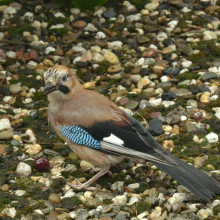
33:37 - It's all about your point of view
It's all about your point of view
with Dr Ljerka Ostojic, The University of Cambridge
Tools and fire are elements that we have bent to our will to make us successful 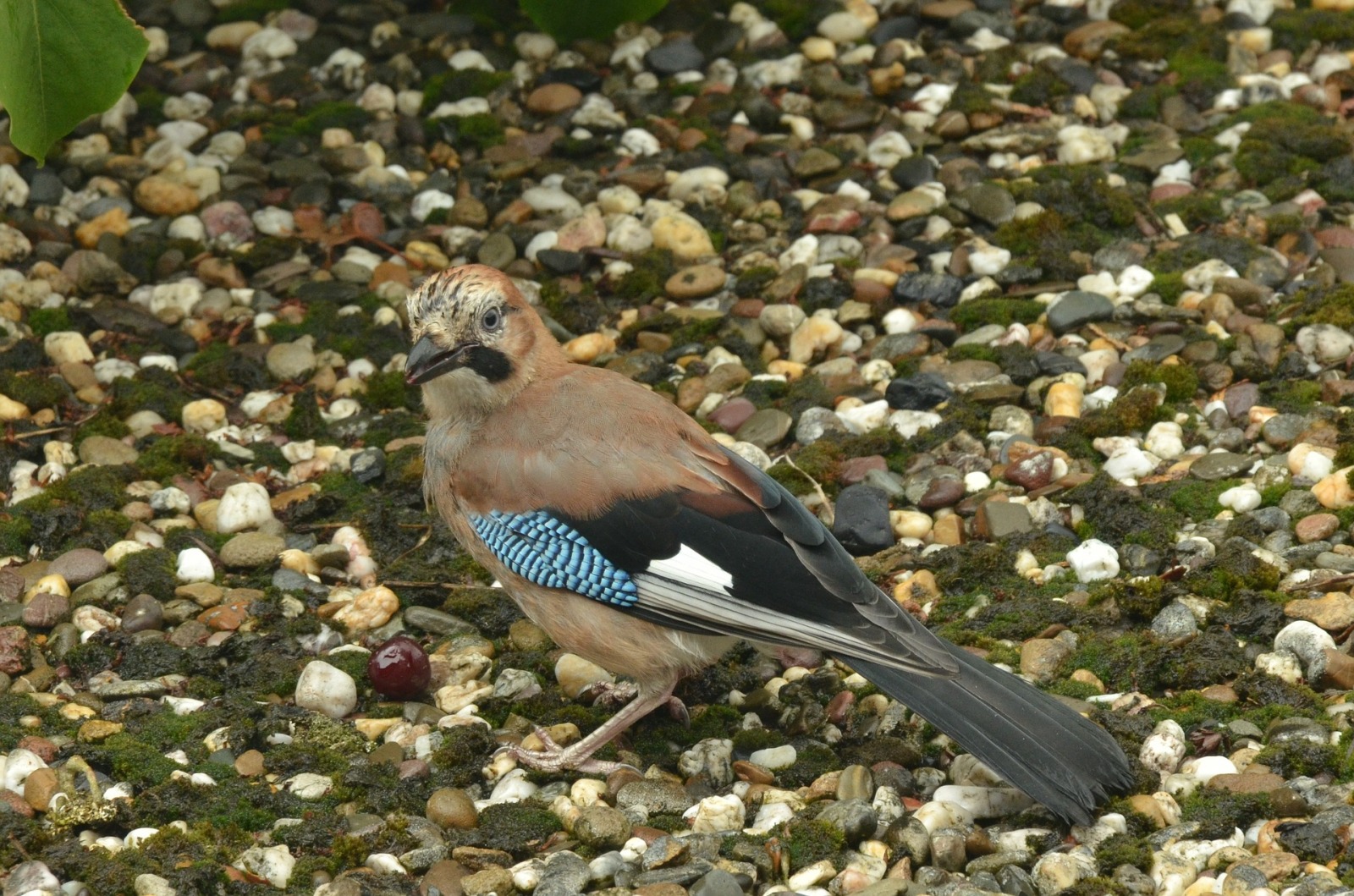 and aid our evolution, but what qualities have we developed as a result of that evolution that help us stand apart from other animals? One quality believed to be uniquely human is our ability to place ourselves mentally in the shoes of others: to work out what another individual is thinking. This is called a theory of mind, but it might not be so uniquely human after all, as Connie Orbach discovered...
and aid our evolution, but what qualities have we developed as a result of that evolution that help us stand apart from other animals? One quality believed to be uniquely human is our ability to place ourselves mentally in the shoes of others: to work out what another individual is thinking. This is called a theory of mind, but it might not be so uniquely human after all, as Connie Orbach discovered...
Connie - Ah, they're so beautiful. Who's this?
Ljerka - This is Quito.
Connie - Quito.
Ljerka - So she is probably one of the most tame ones.
Connie - Hello.
Ljerka - Don't be alarmed, she only has one eye because she had an injury.
Connie - Oh no - what happened?
Ljerka - She got caught in some net.
Connie - Meet Quito, a Eurasian Jay. She can tell us a surprising amount about what it means to be human... She loves the larvae.
Ljerka - Yes, this is her favourite food. I think they have been eating this quite a lot when they were hand raised so these are definitely their favourite food.
Connie - She's one of nine jays being studied by Ljerka Ostojic and her lab at the University of Cambridge to try and establish whether jays were capable of theory of mind. And by that I mean the ability to attribute mental states to others.
Ljerka - So, a very simple example is if you ask a four year old child, while for example I'm going to the fridge, it might say well she wants ice cream. So in this case a child would explain my behaviour based on my desires. It might also say something like she put the ice cream box in the fridge yesterday, so she knows it's still there. So in this case it would also impute some kind of belief state or some knowledge state to me.
Connie - This perspective taking is something that all humans over the age of four can do and has long since been considered a uniquely human trait - but what if it's not? Well that's where the jays come in. Ljerka took me outside to the aviary for a closer look...
Ljerka - This is the aviary where they are living.
Connie - So there's loads of...
Ljerka - Enrichment.
Connie - So that's these toys basically?
Ljerka - Yeah.
Connie - It's a bit like a children's' playground.
Ljerka - Yeah.
Connie - But a bit more airborne.
Ljerka - Yeah. So they like to swing on things and go into boxes and all sorts of things. It also helps with experiments because, given that they are so neophobic, giving them a lot of objects in the aviary helps them also then deal with testing apparatus much quicker.
These birds are quite interesting for us because they exhibit two natural behaviours that we can use quite nicely for our experimental setups. The first behaviour that we utilise is their caching behavior. Especially in autumn, these birds will collect nuts that are available to them, and in nature that would be mostly acorns, in the aviary it is mostly peanuts because they love them and they will hide them for later consumption. So you see now she is putting her head into the gravel, putting the nuts in and then she will take on some stones in the end to put them on top.
Connie - So that's her hiding the nuts for later?
Ljerka - That's her hiding the nuts for later, yeah.
Connie - Eurasian Jays and most other corvids can remember where they left their food, and come back for it later. But that presents them with a problem because if any other jays see them caching - then bingo - that jay will know too. Not so secret after all.
Ljerka - Now that means that once the cacher is gone, the observer comes and can very effectively steal the cache he's made. And this has led to the hypothesis that this might be beneficial for cachers to have evolved cache protection strategies to minimise pilfering loss.
Connie - And this is where theory of mind comes in. Because, if jays do try to hide their food from watching thieves, well they could be attributing a knowledge state to another bird. The researchers here test the birds by observing their behaviour in this situation and others to look for conclusive proof of theory of mind.
Ljerka - So far, I think every published experiment can be criticised in that it might afford some kind of behaviour reading rather than attribution of a mental state. Currently where we are with food sharing is that we are trying to really test what kind of behaviour reading might be going on, and if it doesn't go on but maybe the attribution of the underlying desire might be necessary.
Most theory of mind research is only done on corvids and primates, and so far it has been very difficult to use explicit measures of behaviour to look at theory of mind in primates. Some researchers would argue that we have very good evidence that primates understand others knowledge states, kind of whether they can see or not. Where, so far, there has been no evidence until recently that primates might understand when another individual might have a false belief. So false belief is when you believe something that isn't actually true anymore because something has changed in reality.
Connie - If we were to discover that some animals, all animals, a proportion of animals do exhibit theory of mind - what would that mean in our terms of understanding of our place in the world as humans?
Ljerka - So for those researchers who think that theory of mind is a unique human ability, they would have to rethink that. The other thing about humans is that we maybe have rethink the way we view them regarding theory of mind anyway, because we do have some research showing that theory of mind is not something that we always use or that we use very correctly. So, even though we are definitely capable of that ability in everyday situations, we are sometimes not as good at it as we like to think. There is a lots of research showing that we are biased by our own knowledge states, by our own desire states when we want to respond to other people's desires or other people's knowledge states. And this is also something that we are also finding, for example, with these jays that they are also biased by their current desire when they need to respond to someone else's desire.

39:49 - Ritual: the story of Homo naledi
Ritual: the story of Homo naledi
with Professor Lee Berger, University of the Witwatersrand
Some of our higher mental functions might not be quite as unique as we thought,  but what about other aspects of culture, like religion, or rituals? Again, we had complacently assumed that these were the sole preserve of us modern humans. Or maybe not. Because the announcement in 2015 of the discovery of another early human ancestor, Homo naledi, suggests these individuals might have been burying their dead. Lee Berger told Chris Smith how this discovery came about...
but what about other aspects of culture, like religion, or rituals? Again, we had complacently assumed that these were the sole preserve of us modern humans. Or maybe not. Because the announcement in 2015 of the discovery of another early human ancestor, Homo naledi, suggests these individuals might have been burying their dead. Lee Berger told Chris Smith how this discovery came about...
Lee - Well, first to correct it - I didn't do the discovery - my team did. It was discovered in a most remarkable series of events lead by two amateur explorers who were working with us, who shimmied down a seven and a half inch slot, almost sixty feet underground into a chamber and there, in that chamber, was the most remarkable hominid cache perhaps ever discovered in history.
We did an underground expedition in November of 2013 to recover what I thought, wrongly, was a single skeleton. At the end of that 21 day expedition, we'd found more individual hominin remains than had been discovered in South Africa in the last 90 years. It was tremendous and there are thousands of remains left down there.
What was important was that not only was it a new species, this tiny small-brained species with amongst the smallest brain ever found in the hominid era - 450-550 cubic centimetres, just slightly larger than apes.
Chris - So that's a third of say your brain size, my brain size?
Lee - That's right. And individuals that are about five and half feet tall, which is quite tall, but with very ape-like shoulders but human-like hands that are very, very curved like the most primitive ancestors. A primitive pelvis like Lucy's, but long human-like legs and human-like feet.
That would be incredible in itself to find a cache of new hominid species unexpected like that but what was, I think, even more remarkable was that we eliminated pretty much every other reason for them being there. They weren't dragged there by predators, they weren't washed there, they weren't - as I received an email yesterday - eaten by a giant snake and deposited there, or many other things. But the 15 individuals that we've taken out so far, and there are many more in there, we believe were placed there or dropped there by members of their own species.
Chris - Now just to be clear, this is in South Africa. It's not far from Johannesburg?
Lee - It's right outside of Johannesburg in an area that is called the "Cradle of Human kind" - a UNESCO World Heritage Site. And many of the richest fossil discoveries in all of history, some of them that Richard was referring too. Even archeological discoveries like some of the oldest evidence for the controlled use of fire at a site Swartkrans is only 800 metres away from here, it was right under our nose.
Chris - Is there any other explanation for how these individuals could have got there, such as, they fell in or they had another entrance and it was there home and just got locked in and couldn't get out?
Lee - We see no evidence of collapse - they came in over time. They didn't come in all at once - it wasn't a mass death. There weren't washed in there - there's no predatory damage. So we came to the, perhaps controversial, conclusion that the best explanation was this tiny-brained, ancient human relative was likely putting it's dead in this place, separating them from other animals and caching them away. Now why is that remarkable? People will say - oh elephants do that, there are elephant grave yards. No they don't.
Chris - Could they not have been driven in there by a more intelligent being that was using them as food?
Lee - I think you're asking a question that often I think my colleagues and I find remarkable. Why would we look for a special pleading case, inventing some hurricane outside, or asteroid coming, or humans ritually disposing in a pet cemetery sort of way, rather than just accepting we've been wrong about human special behaviour, human identity, and the idea that we're the only creature that could possibly understand it's own mortality, or some of the other implications, or want to keep it's dead away from the natural environment because they know, as individuals, they are going to die?
Chris - It wasn't easy for them to get in there was it - I wonder why they went to such extraordinary lengths to do that?
Lee - Well, that's a really interesting question and I think all you would have to do, if we are right about this hypothesis, is look at the great extreme efforts that humans go to to prevent their bodies from being taken by the natural elements. We build tombs, we build tunnels, we build catacombs. If you are not in a constructive age, then perhaps finding somewhere very deep and remote within a cave is the best place you know that nothing's going to get to your body.
Chris - You've been quite cautious about dating these specimens. Do we know how old they are, or are you prepared to admit how old they are yet, or do you not have the evidence yet?
Lee - I know how old they are right now; my colleagues know how old they are right now. We are in the process of peer review submission of the papers and peer review - it won't be long. We've been cautious for good reason, we wanted the morphology judged for itself . People have said they're like primitive Homo erectus. People have guessed at the age; people have said 2 million years old, a million years old.
I can tell you that whatever age Homo naledi is, which you'll learn about early next year, it's going to be quite shocking to the entirety of the archaeological and paleoanthropological community because we have not only discovered the species exists but also this potential complex behaviour.
Chris - And these are individuals who are clearly not our ancestors - they are quite different from us.
Lee - We don't know that. The other lesson that came first from [Australopithecus] sediba in 2010 in Homo naledi is that we should be extraordinarily cautious about trying to put pins and say this is our ancestor, this one gave rise to us. Firstly, the fossil records showing that we don't have that amount of information. There are many different species that are out there. Second, the genetic information, the information from proteins, everything else is telling us that there may even be inter-mixings. I think this linear idea of evolution needs to be replaced by something like a braided stream idea that species diverge and converge back and forth at different times and that we are a result of this very deep, very complex experimentation in evolution of hundreds of thousands and millions of years.
Chris - I think we're going to have to have you back aren't we Lee to fill us in on the rest of it?
Incidentally, Tomos Proffitt is also with us. Tomos - do your primates that you study, to they show any interesting ritualistic behaviour?
Tomos - Well, interestingly a couple of months ago there was a paper published about the chimpanzees in the Thai forest in West Africa, and in the Ivory Coast. Where they found that many many chimpanzees. Basically you have these large trees with large buttress roots, and within these buttress roots they found these very strange caches of stones. And they put camera traps in and they observed these chimpanzees and what they found was that often a male chimpanzee would come rushing past the tree, they would pick up one of these stones and they would throw it back into the buttress root whilst exclaiming or shouting. And they would do this repeatedly and this has been suggested as a potential ritualistic behaviour.
Chris - So it served no benefit to them to just dump a stone - a bit like us climbing up a mountain and building a cairn by heaping up stones, this is what they're doing?
Tomos - This is exactly what they used, they used the word cairn. Yeah. I mean we don't know why they are doing this. It could be something to do with communicating over long distances in the rain forests. I mean they make a very loud noise but they equally make a very loud noise when you hit one of these buttress roots. So they don't know why they're doing this and so the general rule of thumb is if you don't know why you're doing something or why they're doing something it's a ritualistic behaviour.
Chris - Thank you Tomos.

47:22 - Cooperate or die?
Cooperate or die?
with Dr Matthew Pope, University College London
It seems that slowly, piece by piece, some of our most treasured human traits  may be proven to be not that special after all, and so then what's left? Well as the poet John Donne once wrote "no man is an island" and that seems truer today than ever before with technology giving us the ability to stay connected with people all over the world. But how did this come about? Connie Orbach headed back to UCL to find out...
may be proven to be not that special after all, and so then what's left? Well as the poet John Donne once wrote "no man is an island" and that seems truer today than ever before with technology giving us the ability to stay connected with people all over the world. But how did this come about? Connie Orbach headed back to UCL to find out...
Matt - I'm Matt Pope. I'm an archaeologist based at the UCL Institute of Archeology.
Humans, if we look at them on the planet today, are more than cooperative we're absolutely hypersocial. Getting the ability for millions of larged-bodied primates with lots of different inclinations, lots of different urges, to live together in very close proximity isn't a miracle, it's a result of a long process of evolution.
A lot of the evolutionary theory looking at the development of human cognition has changed out of all recognition in the past ten or fifteen years. No longer is it classical reasoning or logic that's driving the human brain, it's social cognition, it's our ability to live together to manage those large groupings that's become one of the big drivers of our evolutionary journey.
Connie - What caused this change from less cooperative to something that's hyper-cooperative?
Matt - Certainly by 1.8 million years ago we're seeing a wide range of different environments being exploited and the dispersal from those areas in which our very early stages of evolution took place within Africa. There's lots of things underpinning the adaptation to these different environments.
But certainly one of the things that I think's been kind of underplayed in our evolution is the concept of culture. We can see in primates, their technology, their behaviour isn't just instinctual, it's taught, it's learnt, it's maintained within cultures, maintained within populations. And we're not just hyper-social we're hyper-cultural and a lot of our adaptations are very reliant on effective cultural networks and effective communication.
Connie - So we moved out to new environments. What did they need from us - what did they we suddenly have to do that we didn't have to do before?
Matt - From the get go we're reasonably adaptable and we're probably very adapted to ecotonal areas on the edges between different ecosystems. But moving outside of Africa certainly seems to have happened in two stages. First of all we do see hominins appearing in the Caucasus, in the Indian subcontinent, even into Eastern Asia. But after a million years ago we see this extension into northern latitudes. At that point, you need to be able to adapt. You're talking about environments that have extreme seasonality. You have very cold periods, you have periods through the year in which there's very little in the way of vegetation resources and you're going to need humans to adapt both to the different environmental conditions and to the different ecology to subsist.
Connie - And so how do we do that?
Matt - It's broken down into two different problems. First of all, how do we adapt to different environments? One of the great things that defines human uniqueness on the planet is the scale at which we engineer to protect us and put a barrier between us and environment and that's everything from clothing, through to shelters, through to architecture. And all of these things come in and have a different part to play.
A long part of our early evolution as we adapted to open environments probably resulted in the loss of body hair. The only thing that could have biologically insulated us against the cold. So once these probably hairless, tropically adapted, early humans, Homo erectus, Homo negasti moved into more northerly latitudes there may have been some physiological adaptations but certainly, you could have accelerated that simply by using animal skins and other materials to insulate yourself against the cold.
Connie - So how do you study something like this - what are the kind of artifacts you're looking at?
Matt - Okay. So the archeological record of human evolution, we could pretty much put it down as being 95 percent stone artifacts. These are the only things that are durable enough to last the geological time and geological processes involved. The stone tools can tell us a lot about adaptations. Stone tools go from being very simple cutting objects in the early stages of human evolution but then we start to see specialised forms.
One of those forms we start to see becoming more apparent within Europe are specialised stone tools that have blunted edges on them. Up until that point, stone tools were all about creating sharp edges but then blunted hard, though edges appear and at least continue on for a period of time. And what we think they're being used for is processing skins and processing hides, turning an animal skin effectively into a durable, weatherproof, insulating membrane. That's one of the examples.
At archeological sites we'll eventually find traces of fire. Not usually until after half a million years ago, and the traces of structures within the archaeological record as well. So we're looking at material traces where humans have come together, transformed objects, whether that be stone, wood, bone, material to engineer their own living spaces.
Connie - And in terms of us going forward, we're in a world where we are hyper-social animals but more and more interacting on the digital scale. Do you think this is a problem - do you think we need those social interactions?
Matt - I think humans are always driven by social interaction and by pushing the limits of it. If we think about a group of chimpanzees operating in a forest, we know that they will keep as close together as they can by the limits of sound. We now have an incredible reach as individuals to maintain contact with disperse social groups in a way unimaginable.
We've got here, not because the technology has allowed us, that's just part of it. It's imperative, it's an evolutionary imperative to extend, to strengthen, to maintain our connection. Yeah. It can cause problems for some individuals but actually underlying it is, I think, such a deeply embedded evolutionary driver. I don't really think we've made sense of what we're going to do with it yet but certainly, I don't think that strength of connection has ever been a problem in human evolution. It's often been the answer.
Chris - That was UCL's Matt Pope. Lee - do you agree?
Lee - Well, I think it is an important point. What I would disagree with is the move in northern hemisphere was, perhaps, the thing that made us human. I think the issue that we are perhaps the most peaceful interspecific species that has ever existed is perhaps one of the very last things. Chimpanzees and other complex primates cooperate with each other, but if you put a group of unrelated members into a room this size they will rip each other apart. And yet here we have four breeding age males sitting in a room that aren't related to each other having a relatively peaceful conversation. And so it may be our last thing...
Chris - But when the show's finished that may change.
Lee - but it's going to be a hard thing to test in the archaeological record. But so many sacred cows have been slaughtered in the last few decades with technology, with new discoveries, I wouldn't be surprised if this one fell too.
Chris - Tomos - concur with that?
Tomos - I agree entirely with that. Some primates will also cooperate. You have chimpanzees that will hunt cooperatively but only for short instances of time and only for a very specific reason. Like Lee said, with the humans it's far more complex.
Chris - Matthew...
Matthew - Well, I think the thing that really intrigued me was the society that Lee was saying that these individuals were knowingly burying their dead. That will be one of the real markers. If Lee can find that show places where we're going to find that again and again in the hominin record, that's very exciting.
Chris - Why haven't we found this before? Just briefly.
Lee - I think we just overlooked it. I think we maybe had a Victorian assumption that we were so special and that was our thing. It goes back to any of the great religious texts - that's our thing. We recognise our own mortality and no other animal does.
- Previous Are aliens out there?
- Next Non-invasive prenatal DNA screening










Comments
Add a comment